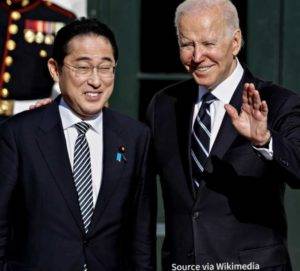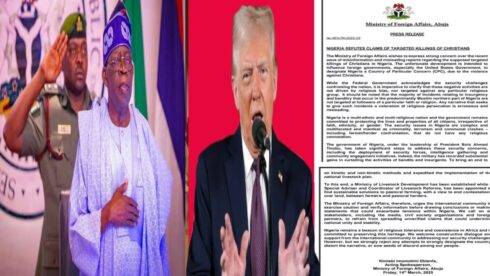In a significant move aimed at countering China’s growing influence in the region, the United States and Japan’s are set to announce the most substantial upgrade to their security alliance since the signing of a mutual defense treaty in 1960. President Joe Biden and Prime Minister Fumio Kishida are poised to unveil plans to restructure the US military command in Japan, enhancing operational planning and joint exercises between the two nations. This development, anticipated to be disclosed during Kishida’s visit to the White House on April 10, underscores the deepening cooperation between the longstanding allies.
The initiative reflects a shared recognition of the escalating security challenges posed by China, prompting a concerted effort to bolster military collaboration and preparedness, particularly in scenarios like a potential conflict over Taiwan. Both leaders are expected to emphasize the resilience and strategic importance of the US-Japan alliance. However, the upcoming summit follows recent tensions sparked by President Biden’s opposition to the acquisition of US Steel by Japan’s Nippon Steel, a move perceived as a bid to shore up domestic support ahead of the November elections. Despite occasional strains, the two nations remain committed to fortifying their security ties in the face of common threats.
Japan’s Defense Build-Up and Regional Security Dynamics
Against the backdrop of mounting regional uncertainties, Japan has embarked on a significant expansion of its defense capabilities, signaling a proactive response to evolving geopolitical dynamics. In recent years, Tokyo has ramped up defense spending, earmarking substantial resources for initiatives such as the procurement of advanced US Tomahawk cruise missiles. Moreover, the establishment of a “Joint Operations Command” within Japan’s Self-Defense Forces underscores the nation’s commitment to enhancing inter-branch coordination and operational effectiveness.
Japan’s proactive defense posture reflects a broader trend of countries in the Asia-Pacific region reevaluating their security strategies amid China’s assertive behavior and growing military capabilities. The strategic realignment between the United States and Japan not only aims to address immediate security challenges but also seeks to foster a durable framework for regional stability and cooperation. As the security landscape continues to evolve, Tokyo’s proactive measures and closer alignment with Washington are poised to play a pivotal role in shaping the dynamics of East Asian security.
Navigating Complexities: Bilateral Relations and Strategic Imperatives
While the US-Japan alliance remains a cornerstone of regional security, navigating the complexities of bilateral relations amidst shifting geopolitical dynamics presents inherent challenges. President Biden’s recent intervention in the business dealings between Nippon Steel and US Steel underscores the intricacies of balancing economic interests with strategic imperatives. Although such actions may strain diplomatic ties, both nations are cognizant of the overarching imperative to reinforce their security partnership in the face of common threats.
The upcoming summit between President Biden and Prime Minister Kishida offers a timely opportunity to reaffirm the enduring strength of the US-Japan alliance while addressing potential areas of friction. By prioritizing enhanced military cooperation and strategic coordination, the two allies aim to bolster deterrence capabilities and preserve regional stability. As they navigate the complexities of an increasingly contested Indo-Pacific, the United States and Japan remain committed to upholding a rules-based order and safeguarding shared interests in the face of evolving security challenges.
Japan’s Urges Enhanced US Military Presence
In a bid to bolster regional defense capabilities amidst growing tensions, Tokyo has emphasized the necessity of deploying a higher-ranking US military officer to Japan. Citing the need to send a robust strategic message to China and North Korea, Japanese officials stress the significance of reinforcing the command structure within the country. According to Oriki, a prominent figure quoted by the Financial Times, such a move would amplify deterrence efforts and affirm US commitment to Japan’s defense.
Proposed Model for Strengthening Alliance
Under the Biden administration’s contemplation, a potential model involves establishing a new US military joint task force, affiliated with the US Pacific Fleet based in Hawaii. This envisaged task force, comprising various branches of the US armed forces, would gradually transition to Japan, facilitating closer cooperation and coordination. Christopher Johnstone, a seasoned Pentagon and CIA alumnus, lauds this initiative as a pivotal stride towards cultivating a more robust bilateral military alliance, poised to swiftly respond to regional threats.
Need for Enhanced Operational Framework
Amidst deliberations, experts emphasize the imperative of refining leadership and operational dynamics between the US and Japan. James Schoff from the Sasakawa Peace Foundation USA underscores the necessity for streamlined planning mechanisms during both peacetime and crises. He advocates for the establishment of a full-time joint staff in Japan to facilitate seamless coordination and trust-building with Japanese counterparts. While alternative models, including the potential elevation of the US Forces Japan (USFJ), are under consideration, the Pentagon remains cautious, awaiting inputs from key stakeholders. The impending discussions between US and Japanese foreign and defense ministers are poised to further address this pivotal issue, shaping the future trajectory of the alliance.
Table of Contents
Discover more from OGM News NG
Subscribe to get the latest posts sent to your email.














